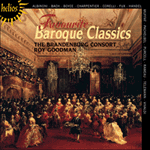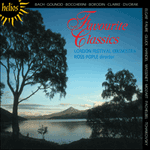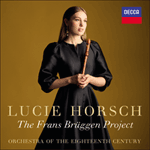The Suite No 3 in D major, BWV1068, is probably Bach’s earliest ensemble suite with a French overture, although we have no evidence to indicate—as has often been stated—that any of these works was composed before Bach’s arrival in Leipzig late in May 1723. Somehow this work, originally tender and intimate in its address, seems to have been transformed totally through the addition of the brass and drum choir, even though this has been very cunningly done; an ingenious detail is the change from repeated notes to rising arpeggio in the first trumpet part at the return to the opening metre in the overture movement. Easily the most famous movement here is the exquisite quartet movement which forms the air; the wonderful thing is the way in which Bach turns a number of commonplace techniques (for example, the ‘striding bass’) to magical effect by his exact manner of combining them; there are beautiful moments in all of the parts. The only pair of alternating movements here are the gavottes, which somehow have a pastoral character before the brass are added, and a hunting style with the trumpets and drums. In courts influenced by French taste, the gavotte would be almost as much of a favourite as the minuet. The bourrée seems to demand a performing speed that is even faster than usual; this movement is another where the trumpet and drum contributions have been very discreetly added, so as nimbly to punctuate or to emphasize the thematic character of the dance. The final gigue is something of a swaggering affair, possibly also intended as a hunting movement. Its style is not that distant from that of the rondo themes of the hunting-finales with which Mozart would, over sixty years later, adorn his horn concertos.
from notes by Stephen Daw © 1996
L’ouverture en ré, BWV1068, est probablement la première suite pour orchestre de Bach avec une ouverture française, bien que nous n’ayons aucune évidence pour prouver—ainsi qu’il a souvent été affirmé—que certains de ces morceaux aient été composés avant l’arrivée de Bach à Leipzig vers la fin de mai 1723. D’une manière ou d’une autre, cet ouvrage, dont l’abord est à l’origine tendre et intime, semble avoir été totalement transformé par l’addition du chœur de trompettes et tambours, bien que cela ait été très habilement effectué; un détail ingénieux est le changement de notes répétées en un arpège ascendant dans la partie de la première trompette, au retour du rythme initial du mouvement d’introduction. Le mouvement le plus célèbre est sûrement l’exquis mouvement en quatuor qui forme l’air; il est merveilleux de voir l’effet magique que Bach obtient en transformant un certain nombre de techniques ordinaires (par exemple la «basse chevauchante») par sa manière exacte de les combiner; il y a des moments très beaux dans toutes les parties. La seule paire de mouvements alternants sont les gavottes qui ont une sorte de caractère pastoral avant l’arrivée des cuivres, et un style de chasse avec les trompettes et les tambours. Dans les Cours influencées par le goût français, la gavotte aurait été aimée autant que le menuet. La bourrée parait demander une vitesse d’interprétation encore plus rapide que d’habitude; ce mouvement est un autre exemple de l’addition discrète de la contribution des trompettes et tambours afin de ponctuer vivement ou d’accentuer le caractère thématique de la danse. La gigue finale est un peu une fanfaronnade, peut-être avec l’intention d’en faire un mouvement de chasse; son style n’est pas si éloigné de celui des thèmes de rondo des finales de chasse avec lesquels Mozart, soixante ans plus tard, embellira ses concertos pour cors.
extrait des notes rédigées par Stephen Daw © 1996
Français: Alain Midoux
BWV1068 in D-Dur ist vermutlich Bachs früheste Orchestersuite mit französischer Ouvertüre, obwohl uns keine Beweise für die oft aufgestellte Behauptung vorliegen, daß auch nur eines dieser Werke vor Bachs Ankunft in Leipzig Ende Mai 1723 komponiert wurde. Irgendwie erscheint dieses in seiner Wirkung ursprünglich zarte und intime Werk total verwandelt durch die Hinzunahme von Blechbläsern und Pauken, auch wenn diese sehr geschickt ausgeführt wurde; ein kunstvolles Detail ist der Wechsel von wiederholten Noten zu aufsteigenden Arpeggien im Part der ersten Trompete bei der Rückkehr zur einleitenden Taktform der Ouvertüre. Die bei weitem bekannteste Passage ist hier der erlesene Quartettsatz des Airs; das Wunderbare daran ist die Art, wie Bach ein Reihe gewohnter Techniken (zum Beispiel den „gehenden“ Baß) einfach dadurch zu magischen Effekten verarbeitet, wie er sie miteinander kombiniert; jeder einzelne Part enthält schöne Momente. Die beiden einzigen alternierenden Sätze sind hier die Gavotten, die pastoral wirken, ehe die Blechbläser hinzutreten, und mit Trompeten und Pauken an Jagdmusik denken lassen. An Höfen, die von französischen Geschmacksvorstellungen beeinflußt waren, wäre die Gavotte fast ebenso beliebt gewesen wie das Menuett. Die Bourrée scheint nach einem Aufführungstempo zu verlangen, das noch schneller ist als üblich; auch diesem Satz wurden sehr diskret Trompeten und Pauken hinzugefügt, um gewandt den thematischen Charakter des Tanzes zu unterstreichen. Die abschließende Gigue wirkt irgendwie großspurig und war vermutlich ebenfalls als Jagdmusik gedacht; ihr Stil ist dem der Rondothemen in den Jagdfinales nicht unähnlich, mit denen Mozart über 60 Jahre später seine Hornkonzerte schmücken sollte.
aus dem Begleittext von Stephen Daw © 1996
Deutsch: Anne Steeb/Bernd Müller


 Favourite Baroque Classics
Favourite Baroque Classics Favourite Classics
Favourite Classics The Frans Brüggen Project
The Frans Brüggen Project
